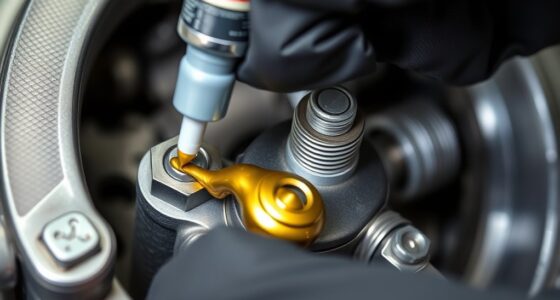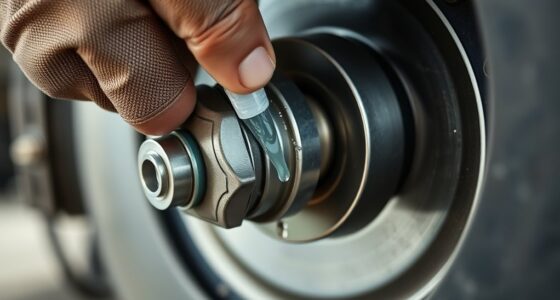To properly hitch your towable splitter, first match your vehicle’s towing capacity with the splitter’s weight and select an appropriate hitch type and size, guaranteeing all components are secure and undamaged. Connect the trailer’s coupler, lock it with a high-quality lock, and attach safety chains in a crisscross pattern. Double-check wiring, lighting, and load balance, then perform safety and alignment checks. Continuing will guide you through each step to ensure a safe and secure connection.
Key Takeaways
- Match the trailer’s weight and coupler size with the vehicle’s towing capacity and hitch components.
- Securely attach the coupler, locking devices, and safety chains in a crisscross pattern for stability.
- Ensure proper alignment of the vehicle and trailer before connection, then double-check all hitch and connection points.
- Connect and test trailer wiring, lights, and signals to ensure visibility and safety during transport.
- Maintain controlled speed, use mirrors effectively, and practice cautious maneuvering to prevent sway or tipping.
Selecting the Right Hitch for Your Splitter and Vehicle
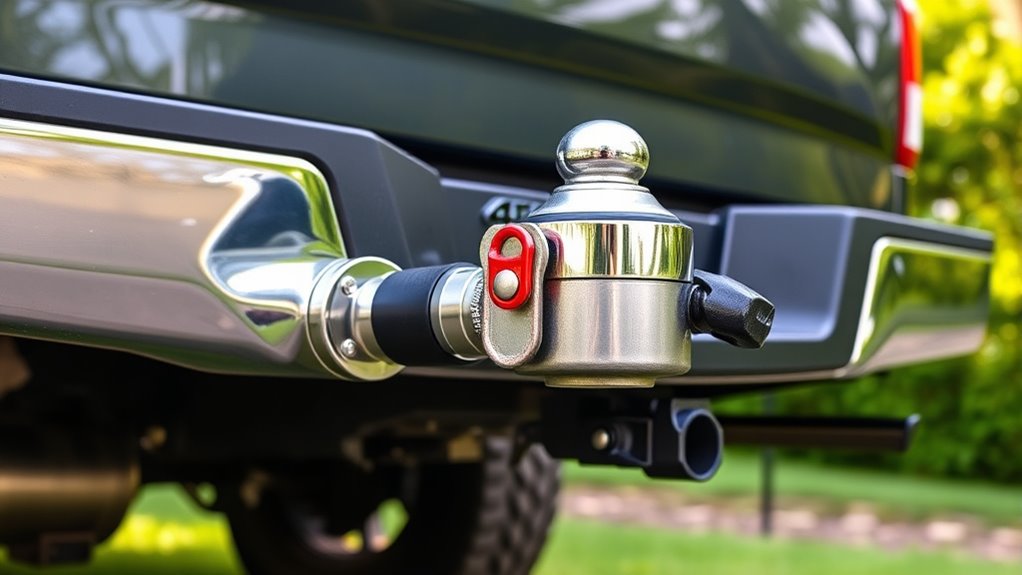
Choosing the right hitch is essential to safely and effectively tow your splitters. First, identify your vehicle’s towing capacity, which you can find in the owner’s manual or on the manufacturer’s website. Then, match it with the weight of your splitter to ensure compatibility. Next, select a hitch type suitable for your vehicle and splitter, like a ball hitch or pintle hitch, depending on the weight and usage. Pay attention to the hitch’s weight ratings, including gross trailer weight and tongue weight, to prevent overloading. Also, consider the hitch receiver size—commonly 2-inch or 2.5-inch—to fit your equipment. Properly matching your hitch to both your vehicle and splitter guarantees safe, stable towing and reduces the risk of accidents. Additionally, understanding the horsepower of electric dirt bikes can help you gauge the power needed for safe towing, especially for heavier splitters. Knowing the parts of a hitch and their functions can further ensure a secure connection.
Inspecting and Preparing Your Equipment Before Hitching
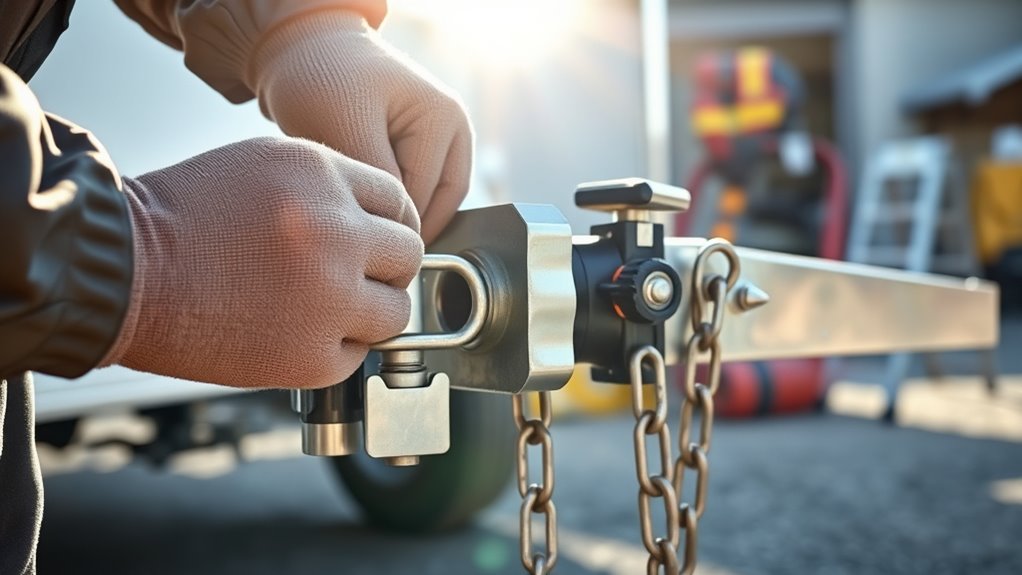
Before hitching, make certain your equipment is in top shape. Check that your hitch is compatible with your splitter and vehicle, and inspect all components for damage or wear. Taking these steps guarantees a safe and smooth towing experience. Additionally, verifying that your hitch setup supports the weight and specifications of your trailer splitter reduces the risk of accidents and ensures optimal performance. Ensuring your hitch materials are durable and corrosion-resistant can extend the lifespan of your towing equipment. Regular inspection and maintenance can help identify potential issues before they become safety hazards. Being aware of essential oils for safety can also promote a calm and alert mindset during operation, contributing to overall safety. Considering vehicle tuning options can further enhance performance and reliability during towing tasks.
Check Hitch Compatibility
Have you checked that your hitch and trailer are compatible before hooking up your splitters? Confirming compatibility is vital for safe towing. Start by verifying that the hitch ball size matches the coupler size on your trailer. For example, a 2-inch coupler needs a 2-inch hitch ball. Next, confirm the weight ratings; the hitch should support the gross trailer weight and tongue weight. Inspect the hitch type—whether it’s a ball mount, pintle, or gooseneck—and make sure your trailer is designed for that setup. Additionally, check that the hitch shank fits securely into your vehicle’s receiver and that all locking mechanisms are in place and functioning properly. Proper compatibility minimizes risks and ensures a smooth, safe connection. Remember to check weight ratings to prevent overloading and ensure safe towing conditions. Always verify hitch compatibility before each use to maintain safety standards. Ensuring the correct hitch type is essential for a secure connection and reliable towing performance.
Examine Equipment Condition
Ensuring your equipment is in proper condition is essential for safe and effective hitching. Before connecting your towable splitter, take a moment to inspect the equipment thoroughly. Check the trailer’s tires for proper inflation and any signs of damage or wear. Properly inflated tires prevent blowouts and improve stability. Examine the hitch and coupler for rust, cracks, or deformation. Confirm they move freely and lock securely. Inspect safety chains, wiring, and lights for damage or corrosion. Confirm all connections are clean, intact, and functioning correctly. Additionally, inspecting equipment maintenance practices can help prevent potential issues and ensure longevity. Regular maintenance can also enhance the overall safety of your towing setup, reducing the risk of accidents on the road. Being aware of Affairs – Cheating Husband Secrets can highlight the importance of trust and reliability in all aspects of your equipment and relationships.
Properly Aligning the Trailer and Vehicle
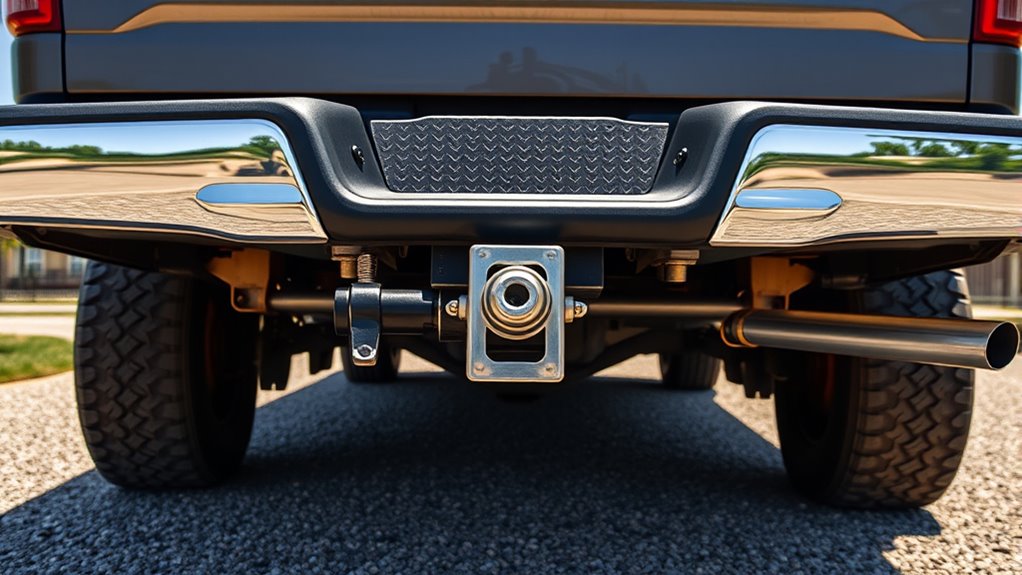
Aligning your trailer and vehicle correctly is essential for safe and efficient towing. Start by positioning your vehicle directly in front of the trailer, ensuring the hitch ball is aligned with the trailer’s coupler. Use your mirrors to check that the trailer is straight and centered behind your vehicle. If your trailer is off-center, back up slowly and make small adjustments until the trailer lines up properly. Keep the steering wheel straight while reversing, and avoid sudden movements. Once aligned, stop and double-check the connection points. Proper alignment minimizes stress on the hitch and reduces the risk of accidents or trailer sway. Regular inspection of equipment is also vital to identify any wear or damage that could compromise safety during towing. Maintaining consistent gym hours can be beneficial if you plan your routines around regular schedules, much like aligning your trailer properly. Taking your time to align correctly ensures a smoother, safer towing experience. Additionally, verifying the proper hitch connection before driving is crucial for safety. Regularly inspecting your equipment helps prevent safety hazards and ensures all components are secure before hitting the road. Incorporating routine inspections into your towing preparations can further enhance safety and reliability.
Securing the Hitch With the Correct Coupler and Locking Mechanisms
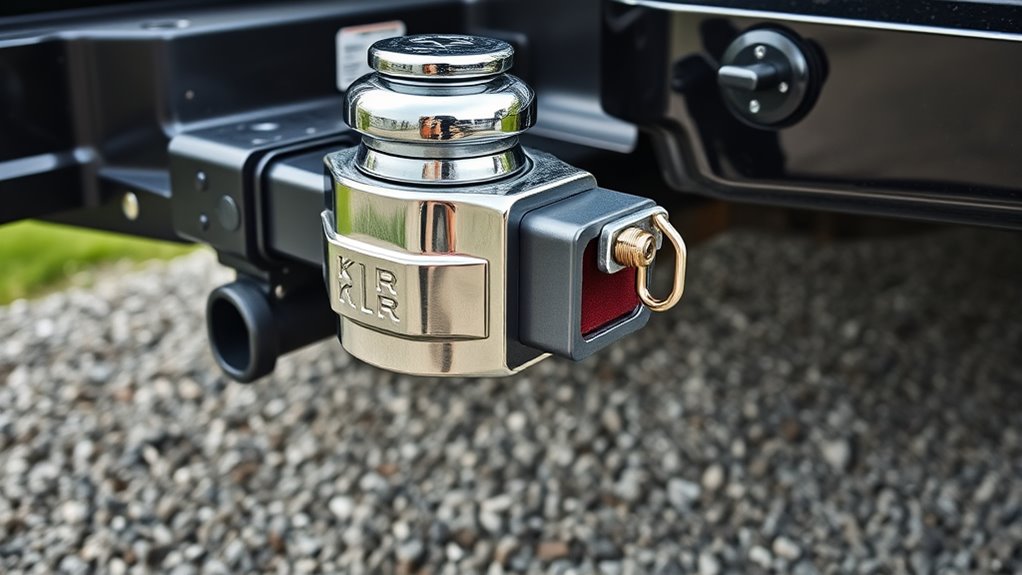
Choosing the right coupler guarantees your trailer stays securely attached during transport. You also need to use locking devices that prevent accidental disconnection. Properly securing your hitch with these components keeps your setup safe and reliable.
Choosing the Right Coupler
Selecting the right coupler is essential for a secure and safe connection between your trailer hitch and towable splitter. You need a coupler that matches your trailer’s ball size and weight capacity. Here’s what to consider:
- Ball Size Compatibility: Ensure the coupler fits your hitch ball diameter, whether 1-7/8″, 2″, or 2-5/16″.
- Weight Rating: Match the coupler’s weight capacity to your splitter’s weight to prevent failure.
- Design Type: Choose a coupler suited for your trailer’s frame, such as a latch, pin, or surge type, for easy attachment and secure locking.
Picking the right coupler guarantees a stable connection, reducing risks during transit. Always double-check specifications before hitching up.
Using Secure Locking Devices
To guarantee your trailer stays securely connected during transport, it’s essential to use the proper locking devices along with your coupler. Always choose a locking mechanism compatible with your coupler type. A lock pin or a locking coupler latch prevents accidental disconnection by securing the hitch in place. Before towing, double-check that the lock is fully engaged and free of damage or corrosion. Use a high-quality padlock or a coupler lock designed for your trailer’s weight and size. This adds an extra layer of security, especially when parking or unattended. Proper locking devices not only prevent detachment but also help deter theft. Regularly inspect and maintain these locks to ensure they function correctly and provide peace of mind during your trip.
Connecting Safety Chains and Additional Security Measures
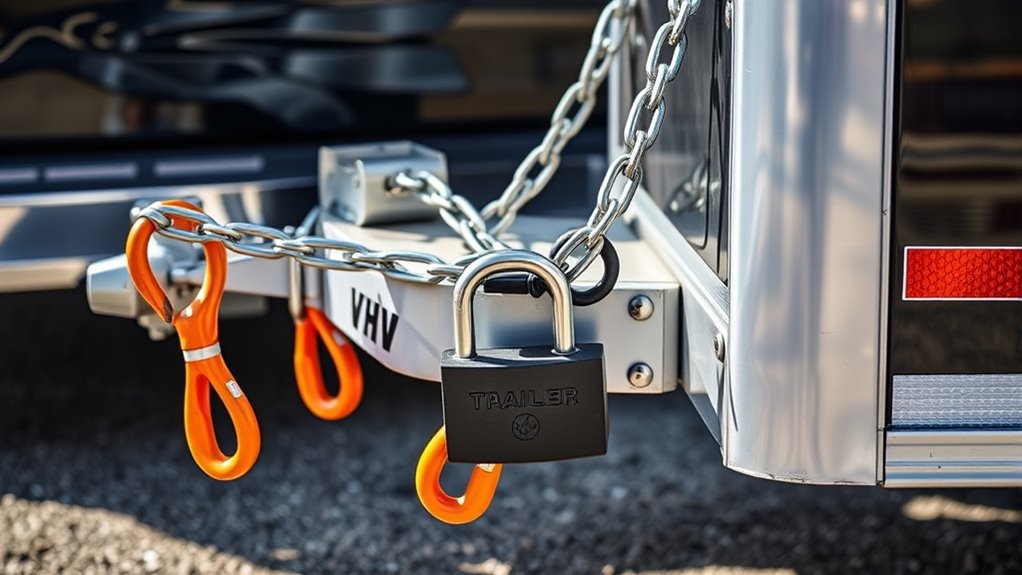
Connecting safety chains properly is essential for secure trailer hitching, especially when towing towable splitters. You want to guarantee the chains form a crisscross pattern beneath the trailer tongue, preventing it from dropping if the hitch fails. Here are key steps to follow:
- Attach the chains to the designated hooks on your vehicle’s frame, avoiding contact with hot or moving parts.
- Cross the chains underneath the tongue, creating an “X” to catch the trailer if it disconnects.
- Keep the chains slack enough for turning but tight enough to prevent excessive movement.
Additionally, consider using safety covers for the chains and inspecting for wear or rust regularly. These measures help secure your load and prevent accidents.
Attaching and Adjusting the Trailer’s Wiring and Lighting Systems
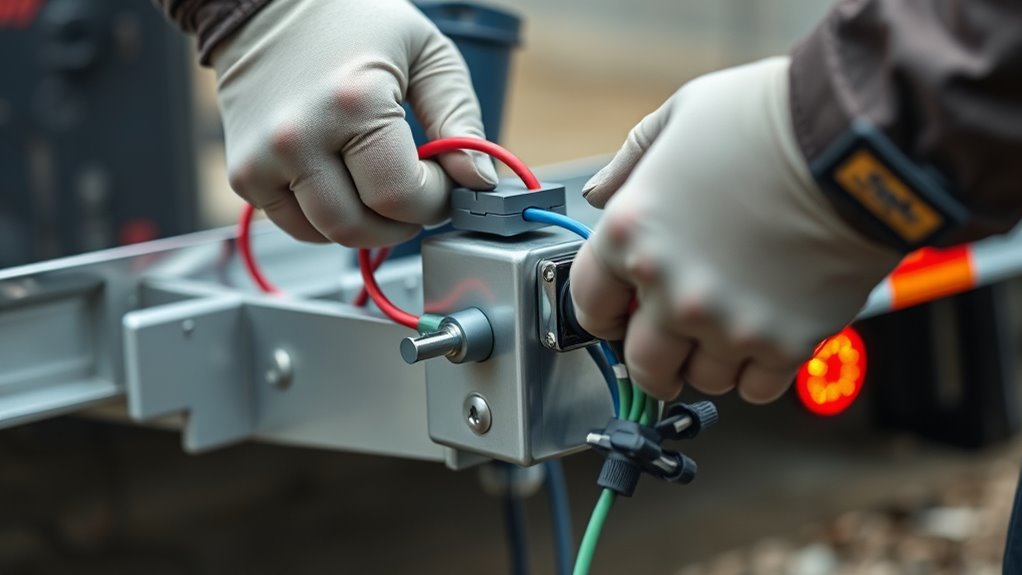
Before hitting the road, you need to make certain your trailer’s wiring and lighting systems are properly attached and adjusted. First, connect the trailer’s wiring harness to your vehicle’s socket, ensuring all pins align correctly. Check that the connection is secure and that no pins are bent or damaged. Turn on your vehicle’s headlights and brake lights to verify the trailer’s signals are working. Adjust the wiring if necessary, using adapters or connectors to ensure compatibility. Confirm that all trailer lights—brake, turn signals, and taillights—are functioning correctly. Properly mounted lights should be visible and not obstructed. This setup ensures your trailer communicates your intentions to other drivers and keeps you compliant with safety regulations.
Conducting a Final Safety Check Before Towing
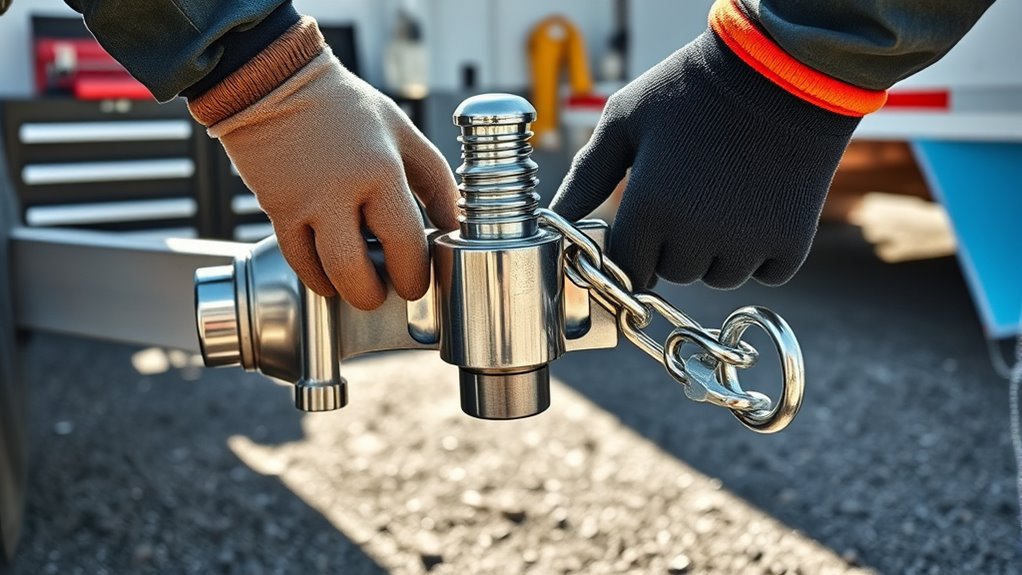
Even after completing all the previous setup steps, it’s crucial to perform a final safety check before hitting the road. This ensures everything is secure and functioning properly. First, walk around the trailer and tow vehicle to verify that the hitch, coupler, and safety chains are properly connected and locked. Second, check that the wiring harness is firmly attached, with all lights functioning correctly—brake, turn signals, and taillights. Third, inspect the load on the trailer to ensure it’s balanced and properly secured, preventing shifting during transport. Confirm that tire pressures match manufacturer specifications and that the trailer’s brakes are operational if equipped. Taking these steps minimizes risks and guarantees safe towing, giving you peace of mind on the road.
Tips for Safe Towing and Maneuvering With Your Towable Splitter
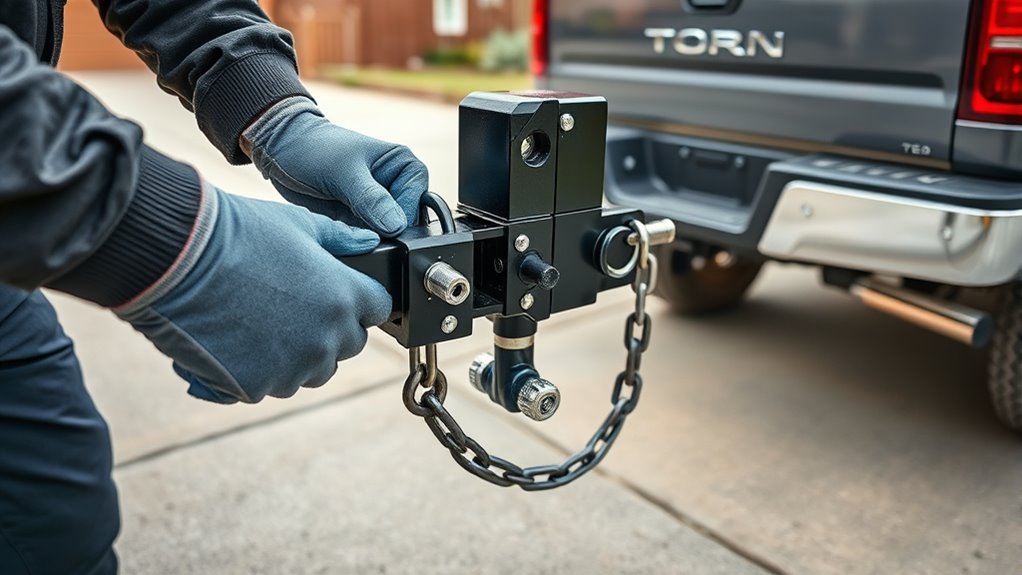
To make certain safe towing and maneuvering with your towable splitter, it’s crucial to drive at a moderate speed and allow extra stopping distance. This helps prevent accidents and ensures control, especially when navigating turns or uneven terrain. Always stay alert for road conditions and other vehicles. Use mirrors effectively to monitor your surroundings. Practice slow, controlled turns to avoid jackknifing or tipping.
| Towing Tip | Rationale |
|---|---|
| Maintain steady speed | Keeps vehicle stable and reduces sway |
| Increase following distance | Allows ample time to stop safely |
| Use smooth steering | Prevents sudden movements that could destabilize the trailer |
| Avoid sharp turns | Reduces risk of trailer sway and tipping |
Frequently Asked Questions
How Do I Troubleshoot Common Hitching Problems During Setup?
When troubleshooting hitching problems during setup, first check if your hitch is properly aligned and secured. Make certain the coupler latch is fully engaged and locked, and inspect the hitch ball for damage or debris. Verify that safety chains are correctly attached and tight. If the trailer isn’t level or feels loose, adjust the hitch height or connections. Regularly inspect components for wear or damage to prevent future issues.
What Are the Signs of an Improperly Secured Trailer?
Ever wonder if your trailer’s secure? You’ll notice if it’s improperly secured when it sways or shifts during movement, or if you hear rattling sounds. Check for a tight connection between the hitch and the ball, and make certain safety chains are properly attached and snug. If the trailer’s uneven or feels loose, that’s a clear sign you need to recheck your hitch setup before hitting the road.
How Often Should I Inspect My Hitch and Trailer Connections?
You should inspect your hitch and trailer connections before each trip, ensuring everything is secure and in good condition. Regular inspections help catch issues like worn-out pins, loose bolts, or rust that could cause accidents. After long hauls or rough terrain, give them a quick check too. Staying vigilant and maintaining your connections keeps you safe on the road and prevents costly damage or injuries.
Can I Tow a Splitter With an Electric or Hybrid Vehicle?
You’re wondering if you can tow a splitter with an electric or hybrid vehicle. Generally, it’s possible if your vehicle’s towing capacity matches the splitter’s weight. Check your vehicle’s specifications to make certain it can handle the load safely. Keep in mind that electric and hybrid vehicles might have limited towing capabilities compared to traditional trucks. Always verify your vehicle’s towing limits and use proper hitching techniques for safe towing.
What Legal Requirements Exist for Trailer Hitching in My State?
You need to know your state’s specific laws for trailer hitching. Check your local Department of Motor Vehicles or transportation website for regulations about hitch weight limits, trailer brakes, and licensing. Some states require safety chains, proper lighting, and specific hitch types. Always guarantee your hitch matches your trailer’s weight and follow all safety guidelines to stay legal and avoid fines or accidents while towing your splitter.
Conclusion
Think of hitching your splitter as painting a perfect picture — each stroke, or step, must align seamlessly. When you select the right hitch, inspect thoroughly, and secure everything properly, you’re creating a safe, smooth journey. Visualize your setup as a well-oiled machine, where every part works in harmony. Follow these tips, and you’ll guarantee your splitter travels safely, like a well-trained team moving as one—ready to conquer any challenge on the road.


